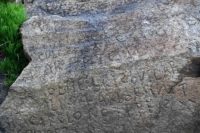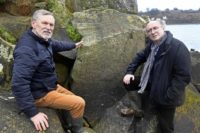 The case of the mysterious inscription on a boulder on the Breton coast may have been cracked, but it still continues to puzzle. Visible only at low tide, the boulder in the village of Plougastel-Daoulas is inscribed with 20 lines of text in capital letters. There are also two dates, 1786 and 1787, and two drawings, a sailboat and a sacred heart. The dates seemed to indicate the age of the inscription, but the text itself was undecipherable. The letters were mostly from the regular French alphabet, but some were upside-down or reversed and there also appeared to be some Ø vowels found in Danish and Norwegian.
The case of the mysterious inscription on a boulder on the Breton coast may have been cracked, but it still continues to puzzle. Visible only at low tide, the boulder in the village of Plougastel-Daoulas is inscribed with 20 lines of text in capital letters. There are also two dates, 1786 and 1787, and two drawings, a sailboat and a sacred heart. The dates seemed to indicate the age of the inscription, but the text itself was undecipherable. The letters were mostly from the regular French alphabet, but some were upside-down or reversed and there also appeared to be some Ø vowels found in Danish and Norwegian.
Local historians and archaeologists were stumped, so last year Mayor Dominique Cap of Plougastel launched a competition, appealing to historians, polyglots and cryptographers around the world to decipher the inscription. The entries would be judged by a jury of academics and an expert from Brittany’s archaeology department, and the most plausible solution awarded €2,000.
 The competition caught on like wildfire. Thousands of emails were sent by would-be decipherers, with a final tally of 61 complete translations submitted from France, the US, Romania, Spain, Norway, Russia, Italy, Brazil and Thailand, among other countries. On Monday the municipality announced that two winning submissions had been selected by the jury: one from Celtic expert and retired English teacher Noël René Toudic and the other from local author Roger Faligot and artist Alain Robet. The winning solutions tell a similar story, but they’re quite different in their particulars.
The competition caught on like wildfire. Thousands of emails were sent by would-be decipherers, with a final tally of 61 complete translations submitted from France, the US, Romania, Spain, Norway, Russia, Italy, Brazil and Thailand, among other countries. On Monday the municipality announced that two winning submissions had been selected by the jury: one from Celtic expert and retired English teacher Noël René Toudic and the other from local author Roger Faligot and artist Alain Robet. The winning solutions tell a similar story, but they’re quite different in their particulars.
Toudic departed from the premise that the inscription was written by a native Breton of limited literacy so he wrote phonetically. It is a memorial to a soldier named Serge Le Bris, engraved by his comrade Grégoire Haloteau. The key part of Toudic’s translation: “Serge died when, badly trained to row, last year his boat was overturned by the wind.” The years mark the date of Serge’s death and the date of the inscription.
Faligot and Robet’s proposed solution is also a memorial to a fallen friend. It is a more complex account of a tragedy and one not written in Breton.
Their translation does not contain names, but speaks of a somebody who was “struck and died” while “at sea at the heart of this violent storm” at a place “near the fortified beach”. The engraver also speaks of having “come to this country” and being taken prisoner.
“Because of the war situation between Britain and France over to the independence struggle in America, there were lots of naval battles just outside the bay,” explains Faligot, author of 50 books, including a history of Brest published in 2016.
“You had lots of prisoners from Wales, Cornwall and England. Not necessarily English-speakers, but also speaking Celtic languages.”
Faligot believes the engraving may be the work of a Welsh prisoner who spoke a language very similar to Breton in order to honour a companion.
“He wanted to do something to say that his friend had drowned that way, and it was extremely sad. He’s also furious with the navy or the army, because he thinks they’re responsible for what happened.”
Neither winner was able to translate the entirety of the inscription, so there’s more work to do. The town also wants to research the names in Toudic’s solution to see if there are any records of a Serge Le Bris and Grégoire Haloteau from the late 18th century.